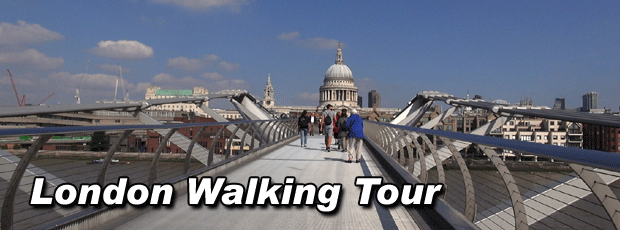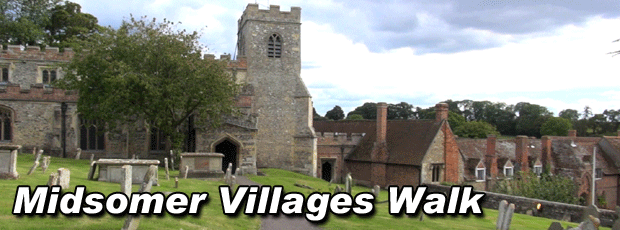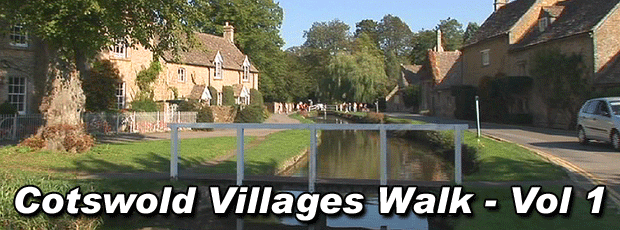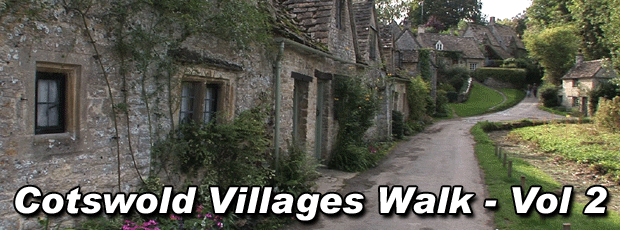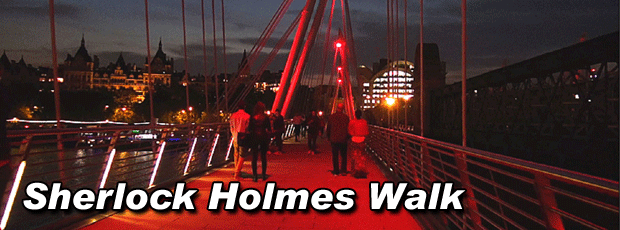-
Your London Walking Tour includes visits to over fifteen historic sites in the capital and most populous city in England
Click on photo at left to watch clips from this video. DVD $14.99 - Download $6.99
-
A 60 minute walk through seven quaint Oxfordshire villages so beautiful that they were used as filming locations for the hit BBC TV Series, "Midsomer Murders."
Click on photo at left to watch clips from this video. DVD $14.99 - Download $6.99
-
Your 60 minute walk through four quaint Cotswold villages: Chipping Campden, Broadway, Upper Slaughter, and ends in Lower Slaughter, arguably one of the most beautiful villages in the Cotwolds.
Click on photo at left to watch clips from this video. DVD $14.99 - Download $6.99
-
A 60 minute walk through 5 more picturesque Cotswold English villages: Snowshill, Stanton, Bourton-on-the-Water, Bibury, and ends in arguably the single most scenic village in all of the Cotswolds, Castle Combe.
Click on photo at left to watch clips from this video. DVD $14.99 - Download $6.99
-
This video will take you on a one hour walk to sixteen filming locations used in the hit BBC Television series about Sherlock Holmes.
Click on photo at left to watch clips from this video. DVD $14.99 - Download $6.99
Your treadmill can transport you to historic England, from London to small villages in the Cotswolds and Oxfordshire!
If you love the United Kingdom, its history, culture, and incredible scenery, then you'll love taking one of our virtual walks through:
LONDON:
Your 60 minute Virtual Walk begins beside the Diana, Princess of Wales Memorial Fountain in London's Hyde Park. Leaving the fountain, you take a brief stroll beside the Serpentine and on through Hyde Park, the largest of the four Royal Parks, until you reach Royal Albert Hall and the Albert Memorial which was commissioned by Queen Victoria in memory of her beloved husband, Prince Albert who died of typhoid in 1861. The unique memorial is 176 feet tall and took over ten years to complete. Next you tour Covent Garden and its unique stalls and shops. Covent Garden was once the location for a fruit-and-vegetable market in the central square but now is a popular shopping and tourist site.
Next this virtual walking tour takes you on a walk through the Leicester Square area with its many ticket booths and movie theaters. Leicester Square is a pedestrianised square in the West End of London and is the prime location in London for film premieres and co-hosts the London Film Festival each year. Leaving Leicester Square on Irving Street, you turn left and walk down Charing Cross Road and pass St. Martin-in-the-Fields Church where there has been a church on the site since the medieval period. The present building was constructed in a Neoclassical design by James Gibbs in 1722–1726.
Your walking tour now enters Trafalgar Square, one of the city's most vibrant open spaces. The site of Trafalgar Square had been a significant landmark since the 13th century and originally contained the King's Mews. After George IV moved the mews to Buckingham Palace, the area was redeveloped by John Nash, but progress was slow after his death, and the square did not open until 1844. The 169-foot Nelson's Column at its centre is guarded by four lion statues.
Next your one hour walking tour of London takes you to and through Piccadilly Circus, known for its video display and neon signs mounted on the corner building on the northern side, as well as the Shaftesbury memorial fountain and statue of Eros. Then on to a quieter part of London and a walk through Green Park before turning right onto the Mall, a road between Buckingham Palace at its western end and Trafalgar Square via Admiralty Arch to the east. Continue walking until you arrive at Buckingham Palace, the home of Queen Elizabeth. Buckingham Palace is the London residence and headquarters of the reigning monarch of the United Kingdom. Located in the City of Westminster, the palace is often at the centre of state occasions and royal hospitality. It has been a focal point for the British people at times of national rejoicing and mourning.
You pause briefly to view the impressive changing of the guard ceremony. Next you move over to Westminster Abbey, one of the most notable religious buildings in the United Kingdom. Westminster Abbey is a large, mainly Gothic abbey church in the City of Westminster, just to the west of the Palace of Westminster. It is the United Kingdom's traditional place of coronation and burial site for English and, later, British monarchs. Then you walk eastward across Parliament Bridge, busy with both foot and vehicle traffic. After crossing Parliament Bridge, you turn and take a brief glimpse of Big Ben, the nickname for the Great Bell of the clock at the north end of the Palace of Westminster, and the Houses of Parliament, the meeting place of the House of Commons and the House of Lords, which governs the United Kingdom.
Walking on to the London Eye which, when erected in 1999, was the world's tallest Ferris wheel and overlooks the South Bank of the River Thames. Next, you move to the Globe Theatre, a modern reconstruction of the original Globe, which was opened in 1997 and just 750 feet from the site of the original theatre. Beginning at the Globe, you walk over the Millennium Bridge, (affectionately known to Londoners as "wobbly bridge") a steel suspension bridge for pedestrians crossing the River Thames. The bridge was closed later on opening day, and after two days of limited access, it was closed for almost two years while modifications were made to eliminate the motion. It reopened in 2002.
Crossing the bridge, you see ahead St. Paul's Cathedral, designed in the English Baroque style by Sir Christopher Wren in the late 17th century. Its construction, completed in Wren's lifetime, was part of a major rebuilding program in the City after the Great Fire of London. Services held at St Paul's have included the funerals of Admiral Nelson, the Duke of Wellington, Sir Winston Churchill and Baroness Thatcher; jubilee celebrations for Queen Victoria; peace services marking the end of the First and Second World Wars; the wedding of Charles, Prince of Wales and Lady Diana Spencer; the launch of the Festival of Britain; and the thanksgiving services for the Silver, Golden and Diamond Jubilees and the 80th and 90th birthdays of Elizabeth II. Entering the garden around St. Paul's Cathedral and walking completely around the outside of the cathedral, you pause for a moment for a look at the front of the famous cathedral.
The last segment of your one hour virtual walking tour of London begins at the Tower of London and a chance to view the moving installation art placed in the Tower's moat, "Blood Swept Lands and Seas of Red." The work consisted of 888,246 ceramic red poppies, each intended to represent one British or Colonial serviceman killed in World War I. Approximately 6,780 poppies were added to the moat each day between 1 July and 11 November 2014, commemorating the centenary of the outbreak of World War I. After walking around the outer wall of the Tower of London, your walking tour ends with a view of the iconic symbol of London, the Tower Bridge.
MIDSOMER MURDERS VILLAGES:
Your 60 minute Village Virtual Walk begins beside the river in the village of Henley-on-Thames. The walk beside the Thames is crowded with people enjoying a sunny August day. Ahead is the Henley Bridge with its five elliptical stone arches, built in 1786. The current bridge replaced an earlier wooden structure, the foundations of which can be seen in the basement of the Henley Royal Regatta headquarters nearby on the Berkshire side. However, the remains of two stone arches on both sides of the river indicate the existence of an even more ancient stone bridge prior to the timber structure.
This bridge has been identified by some authors as the bridge which the Romans crossed pursuing the Britons in 43AD, as described by Dion Cassius. Turning left we cross the street, walk past St. Mary's Church and walk through the village center. Next you enter the village of Dorchester-on-Thames and first pass Dorchester Abbey, then turning onto High Street you pass the George Hotel, one of Britain's oldest coach inns, which dates back to the 15th century and has appeared in many Midsomer Murder episodes. Walking further down High Street, we come to the village's War Memorial.
You next enter Warborough and begin your village walk in the grounds of the parish church of St. Laurence, then turn into the village center, walk past numerous cottages and cross the village's cricket field. After crossing the cricket field, we pass by the Six Bells, a beautiful English Pub dating from the 1600's in the heart of the village, which I'm sure you'll recognize from its numerous appearances in the TV series.
Next we enter Ewelme, and through the grounds of the 15th-century parish church of St. Mary the Virgin. This quiet village is the perfect place to rest by a small pond and watch the ducks play. Then it's on to Watlington, a market town in the Chiltern Hills with several half-timbered structures. Many 16th- and 17th-century cottages and houses survive today in Watlington and some have been little altered. Of course, the village has its War Memorial proudly displayed, one of about 100 free-standing war memorials in Oxfordshire. Then on to the small village of Lewknor and through the grounds of St. Margaret's parish church where you turn right and follow High Street, where many of the cottages in Lewknor are built using flints. It's appropriate that you saved Wallingford for our last village to tour. Wallingford has a strong history in the fictional murder mystery genre.
Agatha Christie, who is buried at nearby Cholsey, lived and worked in Wallingford and Wallingford is the filming location of the fictional village of Causton in the TV series "Midsomer Murders." Turning right onto High Street, we pass another 16th-century coaching inn, The George Hotel and, after crossing another bridge, your one-hour Midsomer Villages Virtual Walk ends, where it started 60 minutes ago, beside the River Thames.
COTSWOLD VILLAGES - VOLUME 1:
The first volume of your 60 minute Cotswold Villages Virtual Walk begins beside the historic St. James Church in the village of Chipping Campden, a small market town in the Cotswold district of Gloucestershire. Passing the Alms House you follow Church Street until it intersects with High Street and once on High Street, you encounter and pass through the famous Market Hall, built in 1627 by Sir Baptist Hicks, a prosperous Wool Merchant of that period. Leaving Market Hall, you pause for a brief look at the typical honey-coloured limestone buildings typical of the Cotswolds, then on down the street and eventually out of the center of Chipping Campden. On the outskirts of Chipping Campden, you pause to admire "Little Orchard," the home of Graham Greene, the prolific English novelist, playwright, short story writer, and critic and his wife Vivien between 1931 and 1933.
Then following the Cotswold Way, a 102-mile footpath and designated National Trail since 2007, you enter the east end of the village of Broadway by passing through a sheep field. Broadway has a wide main street lined with red chestnut trees and honey-coloured Cotswold limestone buildings, many dating from the 16th century. Often referred to as the "Jewel of the Cotswolds," Broadway is a center for arts and antiques and has a unique character all its own with tea rooms, hotels and pubs, all clustered near the expansive village green.
Then it's on to the small village of Upper Slaughter on a footpath beside the River Eye. Upper Slaughter was identified by author Arthur Mee as one of 32 "Thankful Villages." In Enchanted Land (1936), he wrote "that a Thankful Village was one which had lost no men in the Great War because all those who left to serve came home again." Although the village was subject to an air raid, it also lost no men in World War II, an honor held by only 14 villages, known as the "Doubly Thankful Villages."
Climbing the hill and turning to the right, you encounter a sign reading "Flowers in Church." St. Peter's is the quintessential country church complete with working bells and polished pews. The church was renovated in 1877. During that renovation, much of the original fabric was re-used, and the original plan of the medieval church was not greatly altered. St. Peter's is lovingly decorated by local parishioners using flowers grown in their gardens, and after taking time to admire the "Flowers in Church," you move on to the nearby village of Lower Slaughter, entering by walking on a small path beside the River Eye.
As in Upper Slaughter, the village of Lower Slaughter is situated on both banks of the River Eye. Records exist showing that Lower Slaughter has been inhabited for over 1000 years and where most of the 16th and 17th century homes in the village use Cotswold sandstone and are adorned with mullioned windows and often with other embellishments such as projecting gables. You pause to enjoy the profusion of blooming flowers in almost every yard and then cross a stone footbridge and turn left and pause again to view a 19th-century water mill with an undershot waterwheel and a chimney for additional steam power. Behind the water mill, you turn onto a small path and pass through a gate which commemorates a visit by Prince Charles and Lady Diana in 1981. You continue walking northwest out of the village, beside the now wider river where your one hour Cotswold Villages Virtual Walk - Volume 1 ends here beside the River Eye.
COTSWOLD VILLAGES - VOLUME 2:
The second volume of your 60 minute Cotswold Villages Virtual Walk begins outside of the charming village of Snowshill. Walking down the hill and past some typical honey-colored cottages, constructed of local limestone, you eventually reach the center of Snowshill and pause for a moment beside the Church of St. Barnabus and its old graveyard with so many stories to tell. Your walk through Snowshill pauses periodically to contemplate the various quaint cottages found here before leaving the village by way of a tree-lined road you continue on as you next enter the village of Stanton.
Walking behind an elderly gentleman out for a stroll, you stop to take in a lovely thatched-roofed cottage on the outskirts of Stanton. Further on, a group of riders pass as you enter into the center of this traditional Cotswold village. Everywhere you look, green plants are thriving. Following the "Cotswold Way" road post, you leave Stanton and next enter into the picturesque village of Bourton-on-the-Water. The River Windrush flows through the heart of this popular Cotswold village. Your walk follows the footpath beside the river as it cuts through the village.
The idyllic village of Bibury is next on your walk. Starting at the Church, you soon pause at the famous Arlington Row, certainly one of the most well-known and most photographed sites in the Cotswolds. Further on, your walk takes you beside Rack Isle, where dyed woolens were once hung to dry, and on through the village and past the historic Swan Hotel.
And last, your hour-long walk takes you into arguably the most scenic village in all of the Cotswolds, Castle Combe. You follow a narrow forest footpath, and suddenly the village appears - as if by magic. This quintessential old English Village has been the setting of numerous TV programs including an Agatha Christie's Hercule Poirot mystery along with the children's motion picture, Dr. Dolittle. Your walk will actually take you inside this quiet and tranquil church to view the effigy of a knight in a suit of chain mail who has rested here for centuries.
Steven Spielberg's production of "War Horse," nominated for 6 Oscars, along with the motion pictures Stardust and The Wolfman were filmed in this picture-postcard English Village along with the 1999 Neil Gaiman movie, "Stardust." After a complete walking tour of this picturesque village, your 60 minute walk ends at the By Brook.
SHERLOCK HOLMES WALK:
Your 60 minute Sherlock Holmes Virtual Walk will visit sixteen different filming locations used in the hit BBC TV Series about Sherlock Holmes. The walk begins at Russell Square, a large garden square in Bloomsbury. It is in this park in Season 1, Episode 1, where John Watson encounters old friend Mike Stanford sitting at a park bench. Stanford informs John that he has met a man looking for a flat mate - that man is Sherlock Holmes. Your walk continues through the garden at Russell Square past the fountain installed in 2002. The next section of your walk begins in the borough of Soho where in Season 1, Episode 1, Sherlock and John sit at a restaurant window while they wait to meet a murderer. As you walk through Soho, you pass several of the ubiquitous black taxis that populate London streets, similar to the taxi driven by the murderer. After a short five minute walk through Soho, you arrrive at the restaurant and window where Sherlock and John talked as they waited.
Next you travel to London's colorful Chinatown where in Season 1, Episode 2, Sherlock and John attempt to discover the meaning of cryptic symbols left at murder scenes. As they pass the Feng Shui Inn Restaurant, Sherlock realizes that the symbols are an ancient Chinese number system. Your walk continues on through Chinatown. In the same episode, Sherlock and John walk through the middle of Trafalgar Square discussing ancient cryptology methods. And as they continue on through crowded Trafalgar Square, Sherlock admits to John that he needs to consult an expert in painting. That painting "expert" is Raz, a graffiti artist. Later on in the same episode Sherlock, John, and Raz cross the Hungerford Pedestrian Bridge on their way to the South Bank Skate Park to examine more Chinese symbols. Leaving the Hungerford Pedestrian Bridge and continuing straight on for a few more blocks you come to the famous Sherlock Holmes Restaurant, not yet used in any episode of the series - but wouldn't it fun if it was used?
In the same episode, your walk moves to Piccadilly Circus where a man with explosives strapped to his body is forced to make cell phone calls to Sherlock to relay cryptic clues from Moriarty. Next, in Season 2, Episode 1, Sherlock, against his will and wrapped only in a sheet is taken to Buckingham Palace for an important meeting with Mycroft. In the same episode, Irene Adler, "the woman," is driven to her residence at fashionable 44 Eaton Square. And in the same episode, John, under the assumption that he is meeting Mycroft, is actually taken to meet Irene Adler at the old but ionic Battersea Power Station. In the same episode, Irene Adler in a black coat and hood receives the text, "Happy New Year, SH," while standing beside the black glass building on the right of the screen.
In Season 2, Episode 2, you travel to Dartmoor on a very windy day to visit the area where "The Hounds of Baskerville" was filmed. For Season 2, Episode 3, you travel to St. Bart's Hospital in London for possibly the most discussed and controversial scene in the entire TV series. For this pivotal scene, you are standing approximately where John Watson stood when Sherlock jumped from the roof of St. Bart's. You'll stop and view the brick Ambulance Station which blocks John's view of the sidewalk where Sherlock landed. After seeing Sherlock jump, John runs around the left side of the Ambulance Station and is knocked to the ground by a cyclist. After recovering from the collision with the cyclist, John runs towards the sidewalk to find Sherlock's body in a pool of blood on the pavement.
For Season 3, Episode 1, you walk a few blocks to the most familiar location in the entire series "221B Baker Street" beside the real Speedy's Cafe and discover that the door knocker is just the way Sherlock liked to position it, slightly off kilter. If it was perfectly vertical, it would signify that Mycroft - who suffered from OCD - was a visitor! From the same episode, you walk across Westminster Bridge where Sherlock and Mary, on a motorcycle, raced to rescue John before he is consumed in a Guy Fawkes Night bonfire. Next, from Season 3, Episode 2, you walk through St. James' Park where Sherlock and John walked across the Blue Bridge on their way to meet Guardsman Bainbridge at his barracks. Once on the Blue Bridge, you pause to take in a stunning view of St James's Park Lake and the London Eye.
For Season 3, Episode 3, you travel to Bayswater in London for certainly one of the most unusual locations used in the series. For this pivotal scene, Mary travels to Leinster Gardens to search for Sherlock and as she passes this corner, a street beggar hands her a cell phone so she can speak with Sherlock. Sherlock directs Mary to one of the two false façades actually constructed in the late 1860's to allow underground steam locomotives to "vent off" in the opening behind the façades. Your 60 minute Sherlock Holmes Virtual Walk ends at this unusual London location.
Whether you use these Virtual Walks to make the time spent exercising on your treadmill FUN, or use them as a way of "relaxing" after a hard workday, you'll delight in the amazing scenery and vitality captured in these DVDs and HD Downloads.
Customers tell us again and again, that these virtual walk videos actually make the time spent exercising on their treadmills, ellipticals, or Nordic Tracks, "fly by!" They tell us they exercise longer and enjoy every minute! One of our Amazon customers recently posted this review, "These folks that make these DVDs do such a great job that I feel I am actually there! I can't wait to get the next DVD that they make. I am never disappointed."
Another customer wrote: "I LOVE IT!!!!!!! - This is the best virtual exercise dvd I've found so far. I just received it today and I am blown away by it! You feel like you are right there walking down the street. There is no annoying background music only the natural sounds like birds singing, making the virtual experience more realistic. The photography is clear and crisp. It is just the right speed to enjoy all the lovely scenery. It makes you feel like you are on vacation. You walk past vintage cottages with lovely flower gardens and through scenic towns. It is a visual and mental treat. I know I will watch this dvd many times. This seller is excellent. They ship immediately and are great to communicate with. I have purchased several of their other dvd's and will be reviewing them as I watch them. I highly recommend this dvd for anyone who enjoys amazing scenery along with their exercise."
